Abstract
In this study, we reexamined the structural prerequisites for the attachment of P-fimbriated Escherichia coli to human urinary tract epithelial cells. The epithelial cells were obtained from A1P1 nonsecretor individuals, who express the globoseries of glycolipids without the ABH blood group determinants, and from A1P1 secretor individuals, who in addition express globo-A, a receptor for the prsJ96 adhesin. The wild-type E. coli strains J96, AD110, and IA2 and the recombinant clones HB101 papJ96, HB101 prsJ96, HB101 papIA2, and HB101 papAD110 were tested for binding. They expressed P fimbriae, as defined by P blood group-dependent agglutination of human erythrocytes of the globoseries, but differed in reactivity with galactose alpha 1-4galactose beta (Gal alpha 1-4Gal beta)-latex beads, isolated glycolipids of the globoseries, sheep erythrocytes, and uroepithelial cells. Three different patterns of binding were represented among the recombinant clones. HB101 papIA2 and HB101 papAD110 agglutinated sheep erythrocytes and Gal alpha 1-4Gal beta-latex beads and attached to both secretor and nonsecretor epithelial cells. HB101 prsJ96 agglutinated sheep erythrocytes, reacted poorly with Gal alpha 1-4Gal beta-latex beads, and attached to A1 secretor but not to A1 nonsecretor epithelial cells. HB101 papJ96 agglutinated Gal alpha 1-4Gal beta-latex beads but not sheep erythrocytes and attached poorly to human uroepithelial cells. The receptors relevant for adhesion were analyzed by inhibition with glycolipids in suspension. The sheep erythrocyte agglutination and attachment to secretor and nonsecretor epithelial cells of HB101 papIA2 and HB101 papAD110 were inhibited by globotetraosylceramide, while the Forssman glycolipid had no effect. The sheep erythrocyte reactivity and attachment to secretor epithelial cells of HB101 prsJ96 were inhibited by the Forssman glycolipid. These results permitted three conclusions. First, the expression of functionally active Gal alpha 1-4Gal beta-specific adhesins, as in HB101 papJ96, was not sufficient to make E. coli competent to attach to human uroepithelial cells. Attachment required P fimbriae of the papIA2 or papAD110 type. Second, the sheep erythrocyte reactivity of P-fimbriated strains could not be attributed solely to recognition of the Forssman glycolipid and may not be used to define the prsJ96-encoded phenotype. Third, the P-fimbrial adhesins which mediate secretor state-independent attachment to human uroepithelial cells recognized receptor epitopes provided by globotetraosylceramide.
Full text
PDF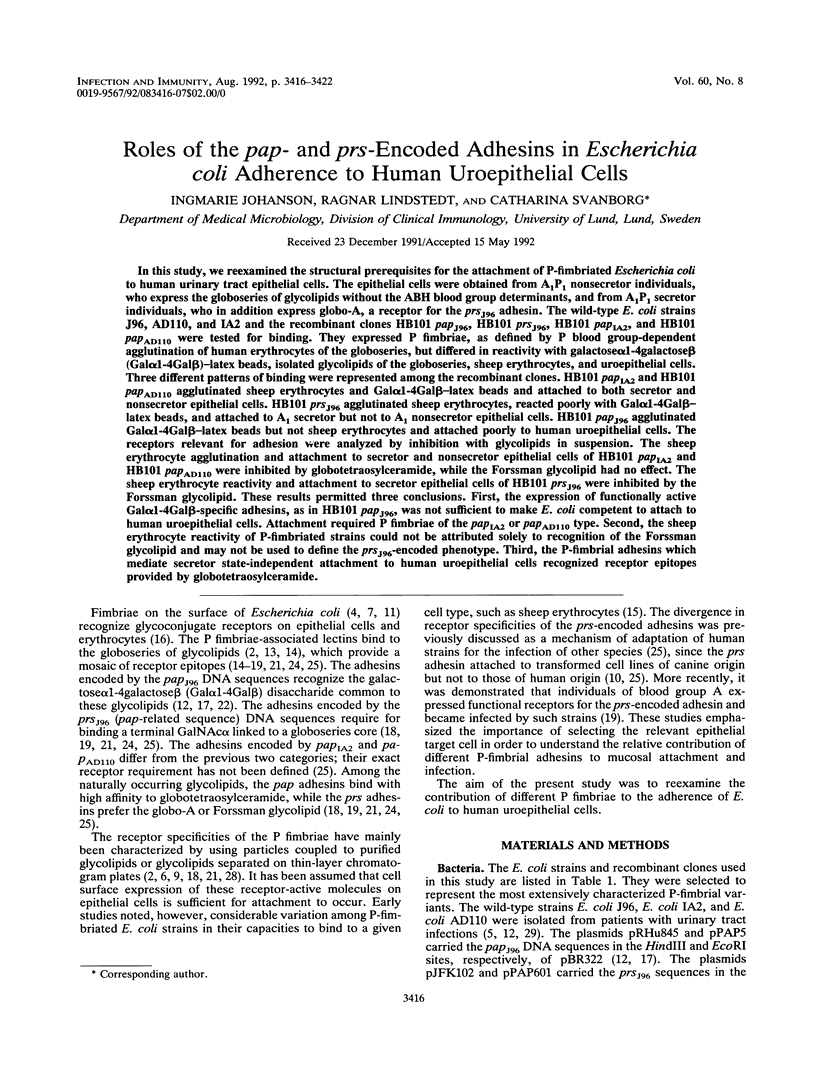
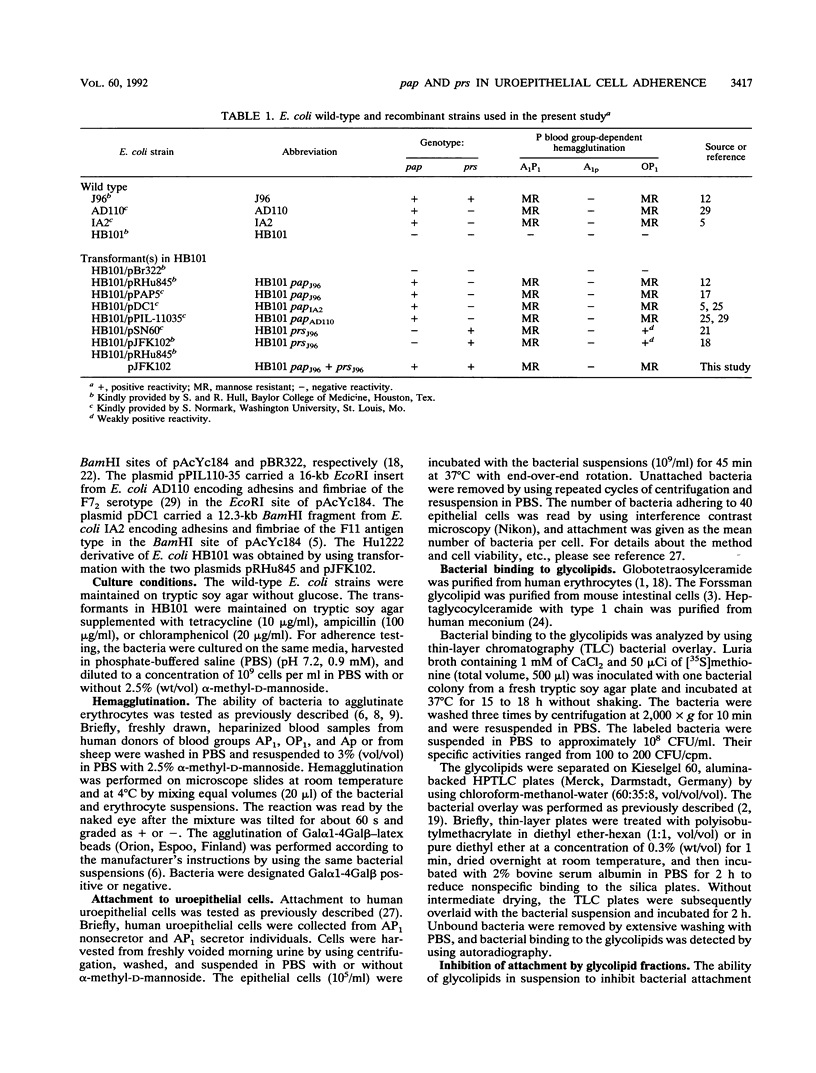
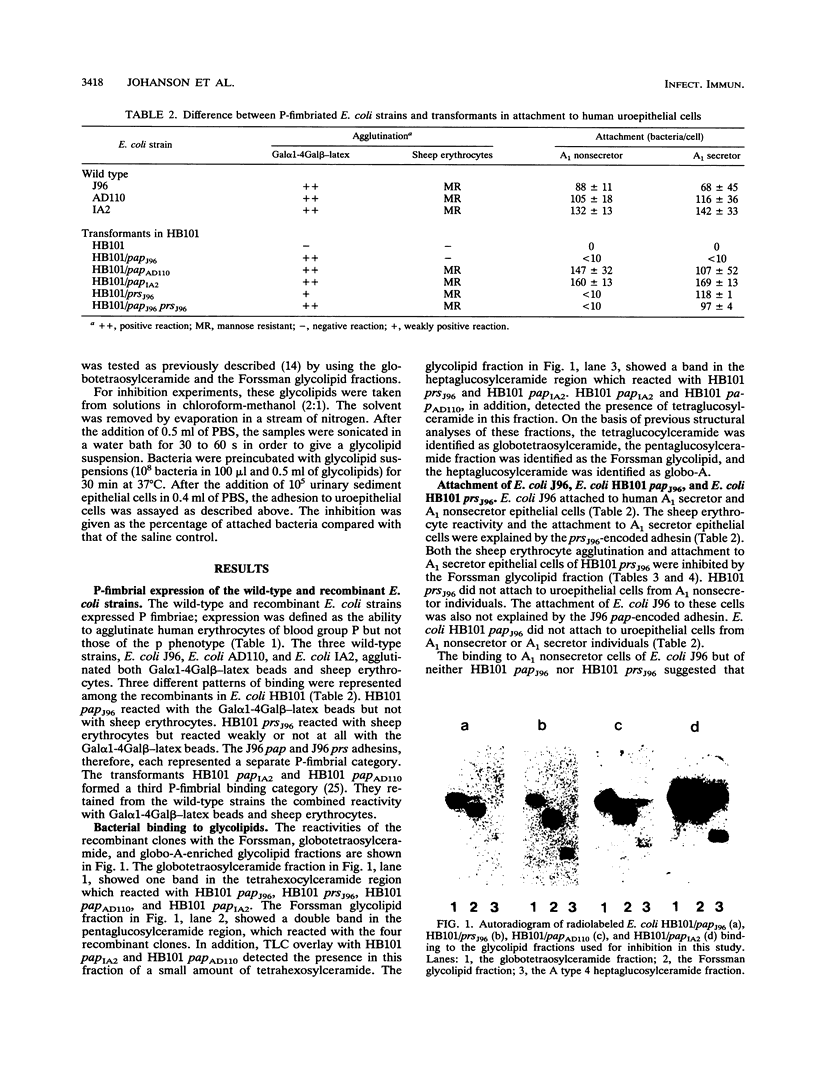
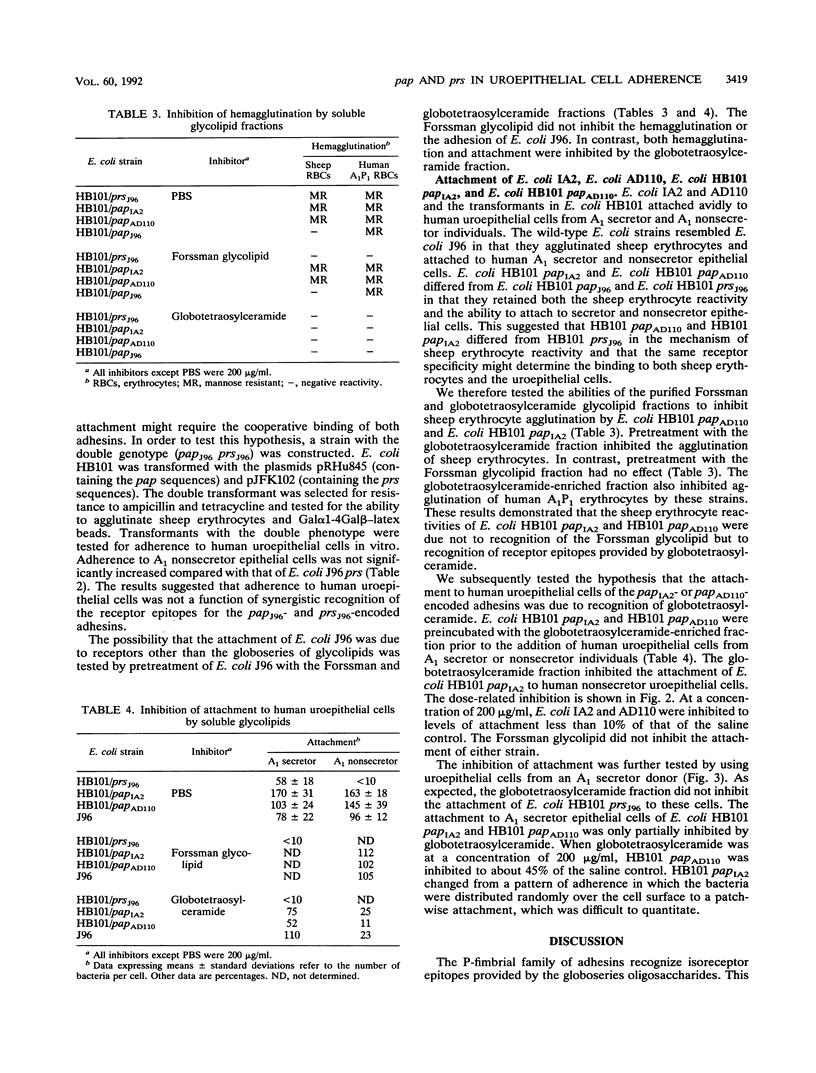


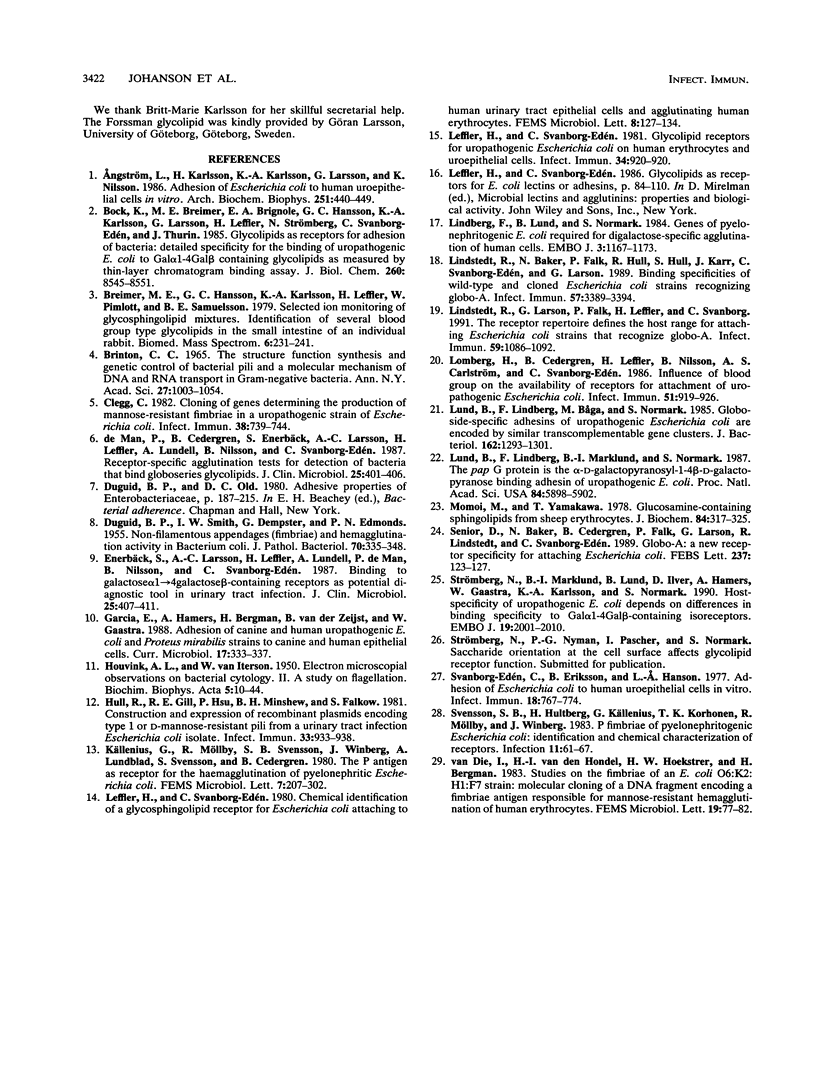
Images in this article
Selected References
These references are in PubMed. This may not be the complete list of references from this article.
- Angström J., Karlsson H., Karlsson K. A., Larson G., Nilson K. GalNAc beta 1----3 terminated glycosphingolipids of human erythrocytes. Arch Biochem Biophys. 1986 Dec;251(2):440–449. doi: 10.1016/0003-9861(86)90350-4. [DOI] [PubMed] [Google Scholar]
- Breimer M. E., Hansson G. C., Karlsson K. A., Leffler H., Pimlott W., Samuelsson B. E. Selected ion monitoring of glycospingolipid mixtures. Identification of several blood group type glycolipids in the small intestine of an individual rabbit. Biomed Mass Spectrom. 1979 Jun;6(6):231–241. doi: 10.1002/bms.1200060603. [DOI] [PubMed] [Google Scholar]
- Brinton C. C., Jr The structure, function, synthesis and genetic control of bacterial pili and a molecular model for DNA and RNA transport in gram negative bacteria. Trans N Y Acad Sci. 1965 Jun;27(8):1003–1054. doi: 10.1111/j.2164-0947.1965.tb02342.x. [DOI] [PubMed] [Google Scholar]
- Clegg S. Cloning of genes determining the production of mannose-resistant fimbriae in a uropathogenic strain of Escherichia coli belonging to serogroup O6. Infect Immun. 1982 Nov;38(2):739–744. doi: 10.1128/iai.38.2.739-744.1982. [DOI] [PMC free article] [PubMed] [Google Scholar]
- DUGUID J. P., SMITH I. W., DEMPSTER G., EDMUNDS P. N. Non-flagellar filamentous appendages (fimbriae) and haemagglutinating activity in Bacterium coli. J Pathol Bacteriol. 1955 Oct;70(2):335–348. doi: 10.1002/path.1700700210. [DOI] [PubMed] [Google Scholar]
- Eden C. S., Eriksson B., Hanson L. A. Adhesion of Escherichia coli to human uroepithelial cells in vitro. Infect Immun. 1977 Dec;18(3):767–774. doi: 10.1128/iai.18.3.767-774.1977. [DOI] [PMC free article] [PubMed] [Google Scholar]
- Enerbäck S., Larsson A. C., Leffler H., Lundell A., de Man P., Nilsson B., Svanborg-Edén C. Binding to galactose alpha 1----4galactose beta-containing receptors as potential diagnostic tool in urinary tract infection. J Clin Microbiol. 1987 Feb;25(2):407–411. doi: 10.1128/jcm.25.2.407-411.1987. [DOI] [PMC free article] [PubMed] [Google Scholar]
- HOUWINK A. L., van ITERSON W. Electron microscopical observations on bacterial cytology; a study on flagellation. Biochim Biophys Acta. 1950 Mar;5(1):10–44. doi: 10.1016/0006-3002(50)90144-2. [DOI] [PubMed] [Google Scholar]
- Hull R. A., Gill R. E., Hsu P., Minshew B. H., Falkow S. Construction and expression of recombinant plasmids encoding type 1 or D-mannose-resistant pili from a urinary tract infection Escherichia coli isolate. Infect Immun. 1981 Sep;33(3):933–938. doi: 10.1128/iai.33.3.933-938.1981. [DOI] [PMC free article] [PubMed] [Google Scholar]
- Leffler H., Svanborg-Edén C. Glycolipid receptors for uropathogenic Escherichia coli on human erythrocytes and uroepithelial cells. Infect Immun. 1981 Dec;34(3):920–929. doi: 10.1128/iai.34.3.920-929.1981. [DOI] [PMC free article] [PubMed] [Google Scholar]
- Lindberg F. P., Lund B., Normark S. Genes of pyelonephritogenic E. coli required for digalactoside-specific agglutination of human cells. EMBO J. 1984 May;3(5):1167–1173. doi: 10.1002/j.1460-2075.1984.tb01946.x. [DOI] [PMC free article] [PubMed] [Google Scholar]
- Lindstedt R., Baker N., Falk P., Hull R., Hull S., Karr J., Leffler H., Svanborg Edén C., Larson G. Binding specificities of wild-type and cloned Escherichia coli strains that recognize globo-A. Infect Immun. 1989 Nov;57(11):3389–3394. doi: 10.1128/iai.57.11.3389-3394.1989. [DOI] [PMC free article] [PubMed] [Google Scholar]
- Lindstedt R., Larson G., Falk P., Jodal U., Leffler H., Svanborg C. The receptor repertoire defines the host range for attaching Escherichia coli strains that recognize globo-A. Infect Immun. 1991 Mar;59(3):1086–1092. doi: 10.1128/iai.59.3.1086-1092.1991. [DOI] [PMC free article] [PubMed] [Google Scholar]
- Lomberg H., Cedergren B., Leffler H., Nilsson B., Carlström A. S., Svanborg-Edén C. Influence of blood group on the availability of receptors for attachment of uropathogenic Escherichia coli. Infect Immun. 1986 Mar;51(3):919–926. doi: 10.1128/iai.51.3.919-926.1986. [DOI] [PMC free article] [PubMed] [Google Scholar]
- Lund B., Lindberg F. P., Båga M., Normark S. Globoside-specific adhesins of uropathogenic Escherichia coli are encoded by similar trans-complementable gene clusters. J Bacteriol. 1985 Jun;162(3):1293–1301. doi: 10.1128/jb.162.3.1293-1301.1985. [DOI] [PMC free article] [PubMed] [Google Scholar]
- Lund B., Lindberg F., Marklund B. I., Normark S. The PapG protein is the alpha-D-galactopyranosyl-(1----4)-beta-D-galactopyranose-binding adhesin of uropathogenic Escherichia coli. Proc Natl Acad Sci U S A. 1987 Aug;84(16):5898–5902. doi: 10.1073/pnas.84.16.5898. [DOI] [PMC free article] [PubMed] [Google Scholar]
- Momoi M., Yamakawa T. Glucosamine-containing sphingoglycolipids from sheep erythrocytes. J Biochem. 1978 Aug;84(2):317–325. doi: 10.1093/oxfordjournals.jbchem.a132131. [DOI] [PubMed] [Google Scholar]
- Senior D., Baker N., Cedergren B., Falk P., Larson G., Lindstedt R., Edén C. S. Globo-A--a new receptor specificity for attaching Escherichia coli. FEBS Lett. 1988 Sep 12;237(1-2):123–127. doi: 10.1016/0014-5793(88)80184-4. [DOI] [PubMed] [Google Scholar]
- Strömberg N., Marklund B. I., Lund B., Ilver D., Hamers A., Gaastra W., Karlsson K. A., Normark S. Host-specificity of uropathogenic Escherichia coli depends on differences in binding specificity to Gal alpha 1-4Gal-containing isoreceptors. EMBO J. 1990 Jun;9(6):2001–2010. doi: 10.1002/j.1460-2075.1990.tb08328.x. [DOI] [PMC free article] [PubMed] [Google Scholar]
- Svenson S. B., Hultberg H., Källenius G., Korhonen T. K., Möllby R., Winberg J. P-fimbriae of pyelonephritogenic Escherichia coli: identification and chemical characterization of receptors. Infection. 1983 Jan-Feb;11(1):61–67. doi: 10.1007/BF01651362. [DOI] [PubMed] [Google Scholar]
- de Man P., Cedergren B., Enerbäck S., Larsson A. C., Leffler H., Lundell A. L., Nilsson B., Svanborg-Edén C. Receptor-specific agglutination tests for detection of bacteria that bind globoseries glycolipids. J Clin Microbiol. 1987 Feb;25(2):401–406. doi: 10.1128/jcm.25.2.401-406.1987. [DOI] [PMC free article] [PubMed] [Google Scholar]



